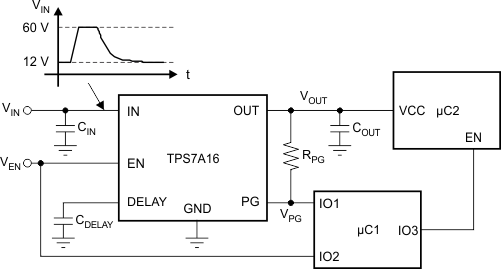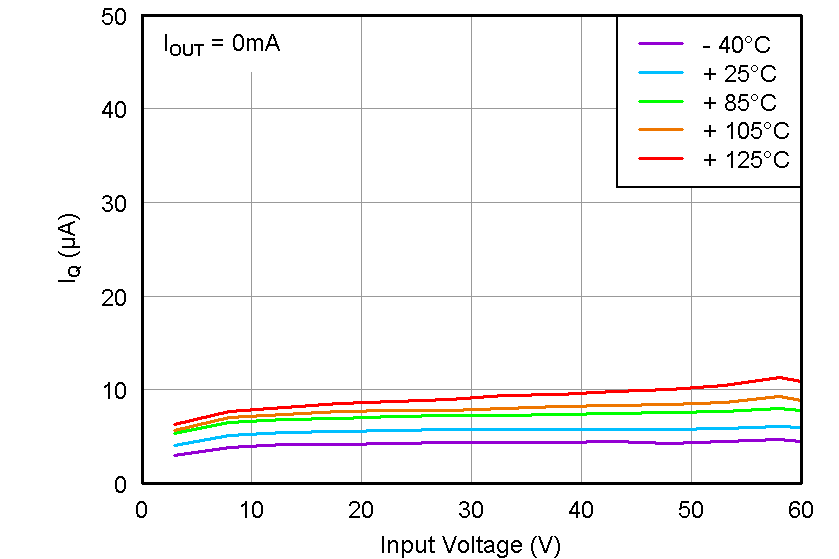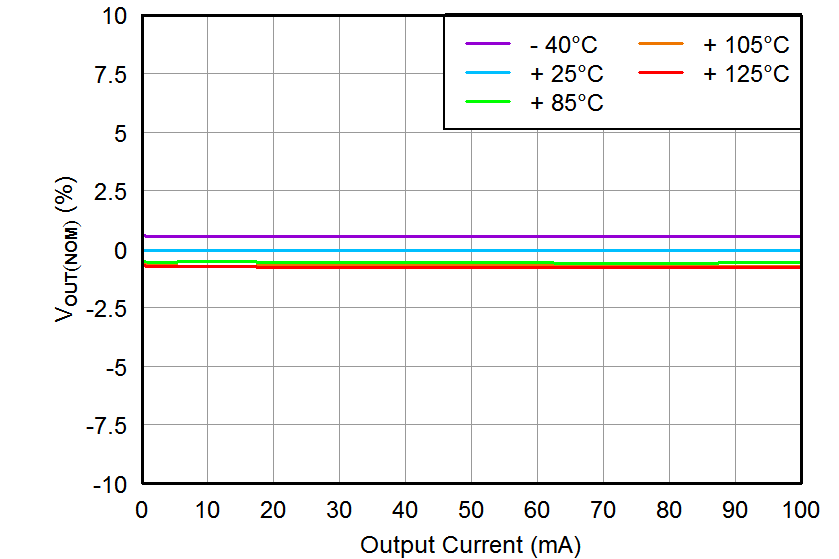-
TPS7A16 60-V, 5-µA IQ, 100-mA, Low-Dropout Voltage Regulator With Enable and Power-Good
- 1 Features
- 2 Applications
- 3 Description
- 4 Revision History
- 5 Pin Configuration and Functions
- 6 Specifications
- 7 Detailed Description
- 8 Application and Implementation
- 9 Power Supply Recommendations
- 10Layout
- 11Device and Documentation Support
- 12Mechanical, Packaging, and Orderable Information
- IMPORTANT NOTICE
パッケージ・オプション
メカニカル・データ(パッケージ|ピン)
サーマルパッド・メカニカル・データ
発注情報
TPS7A16 60-V, 5-µA IQ, 100-mA, Low-Dropout Voltage Regulator With Enable and Power-Good
1 Features
- Wide Input Voltage Range: 3 V to 60 V
- Ultralow Quiescent Current: 5 µA
- Quiescent Current at Shutdown: 1 µA
- Output Current: 100 mA
- Low Dropout Voltage: 60 mV at 20 mA
- Accuracy: 2%
- Available in:
- Fixed Output Voltage: 3.3 V, 5 V
- Adjustable Version from 1.2 V to 18.5 V
- Power-Good With Programmable Delay
- Current Limit and Thermal Shutdown Protections
- Stable with Ceramic Output Capacitors:
≥ 2.2 µF - Packages: High Thermal Performance MSOP-8 and SON-8 PowerPAD™
- Operating Temperature Range:
–40°C to 125°C
2 Applications
- Power Supplies for Notebook PCs, Digital TVs, and Private LAN Systems
- High Cell-Count Battery Packs for Power Tools and other Battery-Powered Microprocessor and Microcontroller Systems
- Car Audio, Navigation, Infotainment, and Other Automotive Systems
- Smoke and CO2 Detectors and Battery-Powered Alarm and Security Systems
3 Description
The TPS7A16 family of ultralow power, low-dropout (LDO) voltage regulators offers the benefits of ultra-low quiescent current, high input voltage and miniaturized, high thermal-performance packaging.
The TPS7A16 family is designed for continuous or sporadic (power backup) battery-powered applications where ultralow quiescent current is critical to extending system battery life.
The TPS7A16 family offers an enable pin (EN) compatible with standard CMOS logic and an integrated open drain active-high power good output (PG) with a user-programmable delay. These pins are intended for use in microcontroller-based, battery-powered applications where power-rail sequencing is required.
In addition, the TPS7A16 is ideal for generating a low-voltage supply from multicell solutions ranging from high cell-count power-tool packs to automotive applications; not only can this device supply a well-regulated voltage rail, but it can also withstand and maintain regulation during voltage transients. These features translate to simpler and more cost-effective, electrical surge-protection circuitry.
Device Information(1)
| PART NUMBER | PACKAGE | BODY SIZE (NOM) |
|---|---|---|
| TPS7A16 | HVSSOP (8) | 3.00 mm × 3.00 mm |
| VSON (8) | 3.00 mm × 3.00 mm |
- For all available packages, see the package option addendum at the end of the data sheet.
Typical Application Schematic

Quiescent Current vs Input Voltage

4 Revision History
Changes from E Revision (August 2015) to F Revision
- Changed ψJB value in Thermal Information table from 141.2 to 11.2 (typo) Go
Changes from D Revision (January 2014) to E Revision
- Added ESD Ratings table, Feature Description section, Device Functional Modes, Application and Implementation section, Power Supply Recommendations section, Layout section, Device and Documentation Support section, and Mechanical, Packaging, and Orderable Information section Go
- Changed MIN value of Regulated output from 1.2 to 1.169 Go
- Changed MAX value of Regulated output from 18 to 18.5 Go
- Changed MAX value of Operating junction temperature from 150 to 125 Go
- Changed value in Power-Good section from 5.5-V to 5-VGo
Changes from C Revision (November 2013) to D Revision
- Changed Feedback Current min, typ, and max values from –1.0, 0.0, and 1.0 to –0.1, –0.01, and 0.1, respectivelyGo
- Changed Enable Current typ value from 0.01 to –0.01Go
Changes from B Revision (April 2013) to C Revision
- Changed DRB package from product preview to production dataGo
- Added DRB package to thermal informationGo
- Changed Figure 4 Y-axis unit from V to mV (typo)Go
Changes from A Revision (December 2011) to B Revision
- Added preview DRB package to data sheet.Go
Changes from * Revision (December 2011) to A Revision
- Changed data sheet to from product preview to production dataGo
5 Pin Configuration and Functions


Pin Functions
| PIN | I/O | DESCRIPTION | |
|---|---|---|---|
| NAME | NO. | ||
| DELAY | 7 | O | Delay pin. Connect a capacitor to GND to adjust the PG delay time; leave open if the reset function is not needed. |
| EN | 5 | I | Enable pin. This pin turns the regulator on or off. If VEN ≥ VEN_HI, the regulator is enabled. If VEN ≤ VEN_LO, the regulator is disabled. If not used, the EN pin can be connected to IN. Make sure that VEN ≤ VIN at all times. |
| FB/DNC | 2 | I | For the adjustable version (TPS7A1601), the feedback pin is the input to the control-loop error amplifier. This pin is used to set the output voltage of the device when the regulator output voltage is set by external resistors. For the fixed voltage versions: Do not connect to this pin. Do not route this pin to any electrical net, not even GND or IN. |
| GND | 4 | GND | Ground pin. |
| IN | 8 | IN | Regulator input supply pin. A capacitor ≥ 0.1 µF must be tied from this pin to ground to assure stability. TI recommends connecting a 10-µF ceramic capacitor from IN to GND (as close to the device as possible) to reduce circuit sensitivity to printed-circuit-board (PCB) layout, especially when long input traces or high source impedances are encountered. |
| NC | 6 | — | This pin can be left open or tied to any voltage between GND and IN. |
| OUT | 1 | O | Regulator output pin. A capacitor ≥ 2.2 µF must be tied from this pin to ground to assure stability. TI recommends connecting a 10-µF ceramic capacitor from OUT to GND (as close to the device as possible) to maximize AC performance. |
| PG | 3 | O | Power-good pin. Open collector output; leave open or connect to GND if the power-good function is not needed. |
| PowerPAD | — | — | Solder to printed-circuit-board (PCB) to enhance thermal performance. Although it can be left floating, TI highly recommends connecting the PowerPAD to the GND plane. |
6 Specifications
6.1 Absolute Maximum Ratings
Over operating free-air temperature range –40°C ≤ TJ ≤ 125°C (unless otherwise noted).(1)| MIN | MAX | UNIT | ||
|---|---|---|---|---|
| Voltage | IN pin to GND pin | –0.3 | 62 | V |
| OUT pin to GND pin | –0.3 | 20 | ||
| OUT pin to IN pin | –62 | 0.3 | ||
| FB pin to GND pin | –0.3 | 3 | ||
| FB pin to IN pin | –62 | 0.3 | ||
| EN pin to IN pin | –62 | 0.3 | ||
| EN pin to GND pin | –0.3 | 62 | ||
| PG pin to GND pin | –0.3 | 5.5 | ||
| DELAY pin to GND pin | –0.3 | 5.5 | ||
| Current | Peak output | Internally limited | ||
| Temperature | Operating virtual junction, TJ | –40 | 150 | °C |
| Storage, Tstg | –65 | 150 | ||
6.2 ESD Ratings
| VALUE | UNIT | |||
|---|---|---|---|---|
| V(ESD) | Electrostatic discharge | Human body model (HBM), per ANSI/ESDA/JEDEC JS-001, all pins(1) | ±2000 | V |
| Charged device model (CDM), per JEDEC specification JESD22-C101, all pins(2) | ±500 | |||
6.3 Recommended Operating Conditions
over operating free-air temperature range (unless otherwise noted)| MIN | NOM | MAX | UNIT | ||
|---|---|---|---|---|---|
| VIN | Unregulated input | 3 | 60 | V | |
| VOUT | Regulated output | 1.169 | 18.5 | V | |
| EN | 0 | 40 | V | ||
| DELAY | 0 | 5 | V | ||
| PG | 0 | 5 | V | ||
| TJ | Operating junction temperature range | –40 | 125 | °C | |
6.4 Thermal Information
| THERMAL METRIC(1) | TPS7A1601 | UNIT | ||
|---|---|---|---|---|
| DGN (HVSSOP) | DRB (VSON) | |||
| 8 PINS | 8 PINS | |||
| RθJA | Junction-to-ambient thermal resistance | 66.2 | 44.5 | °C/W |
| RθJC(top) | Junction-to-case(top) thermal resistance | 45.9 | 49.5 | °C/W |
| RθJB | Junction-to-board thermal resistance | 34.6 | 11.3 | °C/W |
| ψJT | Junction-to-top characterization parameter | 1.9 | 0.7 | °C/W |
| ψJB | Junction-to-board characterization parameter | 34.3 | 11.2 | °C/W |
| RθJC(bot) | Junction-to-case(bottom) thermal resistance | 14.9 | 4.7 | °C/W |
6.5 Electrical Characteristics
At TJ = –40°C to 125°C, VIN = VOUT(NOM) + 0.5 V or VIN = 3 V (whichever is greater), VEN = VIN, IOUT = 10 µA, CIN = 1 μF, COUT = 2.2 μF, and FB tied to OUT, unless otherwise noted.| PARAMETER | TEST CONDITIONS | MIN | TYP | MAX | UNIT | |||
|---|---|---|---|---|---|---|---|---|
| VIN | Input voltage range | 3 | 60 | V | ||||
| VREF | Internal reference | TJ = 25°C, VFB = VREF, VIN = 3 V, IOUT = 10 μA | 1.169 | 1.193 | 1.217 | V | ||
| VUVLO | Undervoltage lockout threshold | 2.7 | V | |||||
| VOUT | Output voltage range | VIN ≥ VOUT(NOM) + 0.5 V | VREF | 18.5 | V | |||
| Nominal accuracy | TJ = 25°C, VIN = 3 V, IOUT = 10 μA | –2% | 2% | VOUT | ||||
| Overall accuracy | VOUT(NOM) + 0.5 V ≤ VIN ≤ 60 V(1)
10 µA ≤ IOUT ≤ 100 mA |
–2% | 2% | VOUT | ||||
| ΔVO(ΔVI) | Line regulation | 3 V ≤ VIN ≤ 60 V | ±1% | VOUT | ||||
| ΔVO(ΔIO) | Load regulation | 10 µA ≤ IOUT ≤ 100 mA | ±1% | VOUT | ||||
| VDO | Dropout voltage | VIN = 4.5 V, VOUT(NOM) = 5 V, IOUT = 20 mA | 60 | mV | ||||
| VIN = 4.5 V, VOUT(NOM) = 5 V, IOUT = 100 mA | 265 | 500 | mV | |||||
| ILIM | Current limit | VOUT = 90% VOUT(NOM), VIN = 3 V | 101 | 225 | 400 | mA | ||
| IGND | Ground current | 3 V ≤ VIN ≤ 60 V, IOUT = 10 µA | 5 | 15 | μA | |||
| IOUT = 100 mA | 5 | μA | ||||||
| ISHDN | Shutdown supply current | VEN = 0.4 V | 0.59 | 5 | μA | |||
| I FB | Feedback current(2) | –0.1 | –0.01 | 0.1 | µA | |||
| IEN | Enable current | 3 V ≤ VIN ≤ 12 V, VIN = VEN | –1 | –0.01 | 1 | μA | ||
| VEN_HI | Enable high-level voltage | 1.2 | V | |||||
| VEN_LO | Enable low- level voltage | 0.3 | V | |||||
| VIT | PG trip threshold | OUT pin floating, VFB increasing, VIN ≥ VIN_MIN | 85% | 95% | VOUT | |||
| OUT pin floating, VFB decreasing, VIN ≥ VIN_MIN | 83% | 93% | VOUT | |||||
| VHYS | PG trip hysteresis | 2.3% | 4% | VOUT | ||||
| VPG, LO | PG output low voltage | OUT pin floating, VFB = 80% VREF, IPG= 1mA | 0.4 | V | ||||
| IPG, LKG | PG leakage current | VPG= VOUT(NOM) | –1 | 1 | μA | |||
| IDELAY | DELAY pin current | 1 | 2 | μA | ||||
| PSRR | Power-supply rejection ratio | VIN = 3 V, VOUT(NOM) = VREF, COUT = 10 μF, f = 100 Hz |
50 | dB | ||||
| TSD | Thermal shutdown temperature | Shutdown, temperature increasing | 170 | °C | ||||
| Reset, temperature decreasing | 150 | °C | ||||||
| TJ | Operating junction temperature range | –40 | 125 | °C | ||||
(24 V – VREF) × 50 mA ≈ 1.14 W). The device is capable of sourcing a maximum current of 50 mA at higher input voltages as long as the power dissipated is within the thermal limits of the package plus any external heatsinking.
6.6 Typical Characteristics
At TJ = –40°C to 125°C, VIN = VOUT(NOM) + 0.5 V or VIN = 3 V (whichever is greater), VEN = VIN, IOUT = 10 µA, CIN = 1 μF, COUT = 2.2 μF, and FB tied to OUT, unless otherwise noted.











